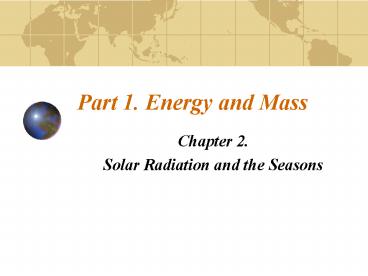Part 1. Energy and Mass - PowerPoint PPT Presentation
Title:
Part 1. Energy and Mass
Description:
Title: Understanding Weather and Climate Ch 2 Author: Anthony J. Vega Last modified by: ytang Created Date: 12/18/2000 12:31:17 AM Document presentation format – PowerPoint PPT presentation
Number of Views:56
Avg rating:3.0/5.0
Title: Part 1. Energy and Mass
1
Part 1. Energy and Mass
- Chapter 2.
- Solar Radiation and the Seasons
2
Introduction
- Solar Radiation
- Initiates atmospheric motions and weather
processes - Energy Classified as
- Kinetic or potential
3
(No Transcript)
4
(No Transcript)
5
- Intensity and Wavelengths of Emitted Radiation
- Energy radiated over many wavelengths
- Physical laws define the amount and wavelength of
emitted energy - Blackbodies hypothetical perfect emitters
6
- Stefan-Boltzmann Law
- Energy emitted is proportional to temperature
- Hotter objects emit more energy
- I ?T4
- Graybodies emit a percentage of the maximum
possible for a temperature - I e?T4
7
- Weins Law
- Determines peak wavelength
- ?max 2900/T
- Hotter objects shorter wavelengths
- Solar radiation 0.5?m peak ?
- Terrestrial radiation 10?m peak ?
8
(No Transcript)
9
- The Solar Constant
- Energy intensity decreases in proportion to the
distance squared - Inverse square law
- Solar emission
- 3.865x1026W /4?(1.5x1011m)2 1367 W/m2
10
(No Transcript)
11
- Causes of the Earths Seasons
- Orbital alignment to the Sun seasonal
variations in solar energy - Revolution
- The ecliptic plane
- Perihelion (Jan 3 147 mil km, 91 mil mi)
- Aphelion (July 3 152 mil km, 94 mil mi)
- Seasonal radiation variation 7
12
(No Transcript)
13
- Earth Rotation
- Once every 24 hours
- Rotational axis offset by 23.5o
- Axis is fixed
- Changes hemispheric orientation through orbit
- Causes seasons
14
Extreme Hypothetical Axis Orientation
15
- Solstices
- Maximum axial tilt in relation to the Sun
- June and December
- Hemispheric axes inclined toward or away from Sun
- Causes maximum or minimum solar radiation receipt
16
(No Transcript)
17
- June Solstice ( June 21)
- Subsolar point Tropic of Cancer (23.5oN)
- December Solstice ( Dec. 21)
- Subsolar point Tropic of Capricorn (23.5oS)
- Subsolar Point Migrates 47o
- Between the Tropics
18
(No Transcript)
19
(No Transcript)
20
- Equinoxes
- Temporally centered between solstices
- March 21 and Sept 21
- The subsolar point 0o
21
(No Transcript)
22
- Solar Angle
- Radiation is proportional to solar angle
- Higher angles equal reduced beam spreading
greater heating
Angle of incidence
23
- Period of Daylight
- Circle of illumination unequally bisects
latitudes - Day length changes across latitudes
- Latitudes are equally split everywhere on
equinoxes
24
(No Transcript)
25
Lower Angles Increased Path Length






























